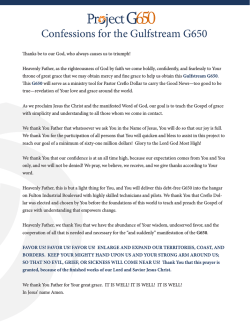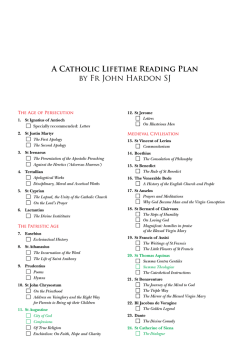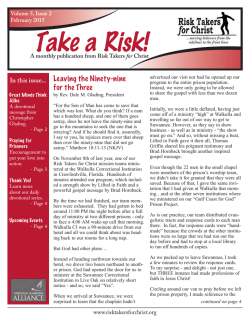
Download - Church of the Redeemer
CHURCH OF THE REDEEMER 717 North Stapley Drive, Mesa, AZ 85203 Phone: (480) 833-7500 Series: Number: Text: Date: The Heidelberg Catechism 20 John 1:1-14 February 1, 2015 a.m. Pastor/Teacher Gary L.W. Johnson The Only Begotten Son of God 13. Lord’s Day Question 33. Why is Christ called the “only begotten Son” of God, since we are also the children of God? Answer: Because Christ alone is the eternal and natural Son of God; (a) but we are children adopted of God, by grace, for his sake. (b) (a) John 1:1 In the beginning was the Word, and the Word was with God, and the Word was God. John 1:2 The same was in the beginning with God. John 1:3 All things were made by him; and without him was not any thing made that was made. John 1:14 And the Word was made flesh, and dwelt among us, (and we beheld his glory, the glory as of the only begotten of the Father,) full of grace and truth. John 1:18 No man hath seen God at any time; the only begotten Son, which is in the bosom of the Father, he hath declared him. Heb. 1:1 God, who at sundry times and in divers manners spake in time past unto the fathers by the prophets, Heb. 1:2 Hath in these last days spoken unto us by his Son, whom he hath appointed heir of all things, by whom also he made the worlds; John 3:16 For God so loved the world, that he gave his only begotten Son, that whosoever believeth in him should not perish, but have everlasting life. 1 John 4:9 In this was manifested the love of God toward us, because that God sent his only begotten Son into the world, that we might live through him. Rom. 8:32 He that spared not his own Son, but delivered him up for us all, how shall he not with him also freely give us all things? (b) Rom. 8:15 For ye have not received the spirit of bondage again to fear; but ye have received the Spirit of adoption, whereby we cry, Abba, Father. Rom. 8:16 The Spirit itself beareth witness with our spirit, that we are the children of God: Rom. 8:17 And if children, then heirs; heirs of God, and joint-heirs with Christ; if so be that we suffer with him, that we may be also glorified together. John 1:12 But as many as received him, to them gave he power to become the sons of God, even to them that believe on his name: Gal. 4:6 And because ye are sons, God hath sent forth the Spirit of his Son into your hearts, crying, Abba, Father. Eph. 1:5 Having predestinated us unto the adoption of children by Jesus Christ to himself, according to the good pleasure of his will, Eph. 1:6 To the praise of the glory of his grace, wherein he hath made us accepted in the beloved. Newsweek magazine launched a broadside attack on the Bible in its cover story for December 23, 2014 entitled “The Bible: So Misunderstood It’s a Sin.” The hatchet job was the work of Kurt Eichenwald, a regular reporter for The New York Times and Vanity Fair. His background is in business and finance – he has ZERO training in Biblical and theological fields – and it shows. Albert Mohler describes it as “an irresponsible (screed) of post-Christian (invective) leveled against the Bible and, even more to the point, against evangelical Christianity. It is one of the most irresponsible articles ever to appear in a journalistic guide.”1 A number of very capable evangelical scholars took Eichenwald out to the proverbial woodshed and gave him a well-deserved whipping.2 Over the past few years the kind of 1 garbage that Newsweek dished out has become fairly common. The most blatant appeared in the novel The Da Vinci Code. With over 46 million copies in print, Dan Brown’s The Da Vinci Code has become a major factor in determining how people view Jesus and the Christian faith. Evangelical Christians in particular are worried about the influence on the faith from a single source they regard as a piece of well-written fiction that masquerades itself as historical fact. The movie version of The Da Vinci Code was released in 2006 and became the second highest grossing film of the year. An amazing amount of scholarly response, primarily by Evangelicals criticizing the story and calling into question Brown’s claims that the book is “historically” accurate. To give just one example, noted evangelical New Testament scholar Ben Witherington III of Asbury Theological Seminary is following up the criticisms of the novel in his book, The Gospel Code, with lectures in Singapore, Turkey, and 30 U.S. cities. He’s given 55 broadcast interviews.3 The conservative Roman Catholic group Opus Dei, portrayed as villainous in the story, is among those asking Sony Corp. to issue a disclaimer with the film. Assaults on “Da Vinci” don’t just come from evangelicals like Witherington, or from Roman Catholic leaders such as Chicago’s Cardinal Francis George, who says Brown is waging “an attack on the Catholic Church” through preposterous historical claims. Among more liberal thinkers, Harold Attridge, dean of Yale’s Divinity School, says Brown has “wildly misinterpreted” early Christianity. Bart Ehrman, who teaches religion at the University of North Carolina at Chapel Hill, likens the phenomenon to the excitement in the 19th century when deluded masses thought Jesus would return in 1844 (which gave birth to the Seventh-day Adventists). Ehrman, whose own book, (Misquoting Jesus), proposed a radical approach to the text of the New Testament,4 nonetheless sees Brown’s book in a decidedly negative light. The novel’s impact on religious ideas in popular culture, he says, is “quite unlike anything we’ve experienced in our lifetimes.” Ehrman details Brown’s numerous mistakes in truth and fiction in The Da Vinci Code and asks: “Why didn’t he simply get his facts straight?” The problem is that The Da Vinci Code is billed as more than mere fiction. Brown’s opening page begins with the word “FACT” and asserts that all descriptions of documents “are accurate.” “It is a book about big ideas, you can love them or you can hate them,” Brown said in a speech last week. “But we’re all talking about them, and that’s really the point.” Brown told National Public Radio’s “Weekend Edition” during a 2003 publicity tour (he declines interviews now) that his characters and action are fictional but “the ancient history, the secret documents, the rituals, all of this is factual.” Around the same time, on CNN he said, “the background is all true.” But as documented above, Christian scholars from across the spectrum beg to differ. Among the key issues none is more critical than the way The Da Vinci Code approaches the doctrine the divinity of Christ. Brown’s version in “Da Vinci” viewed Jesus as a mere mortal until A.D. 325 when the Emperor Constantine “turned Jesus into a deity” by getting the council of Nicea to endorse divine status by “a relatively close vote.” This is just one example where Brown deliberately resorts to falsehood. Contrary to Brown’s blatant distortion, this was not done for “political reasons” nor was it a “close vote.” There were 318 bishops in attendance at Nicea and 316 affirmed the statements in its creed and only 2 abstained.3 Ancient church experts like Larry Hurtado of Scotland’s University of Edinburgh, whose highly acclaimed book on the Person of Christ examines first century belief in Jesus’ divinity, says that “on chronology, issues, developments, and all the matters asserted, Brown strikes out; he doesn’t even get on base.” He and others cite the worship of Jesus in epistles that Paul wrote in the 50’s A.D. One passage teaches that Jesus, “though he was in the form of God, did not count equality with God a thing to be grasped” and became a man (Philippians 2:6). Furthermore, historians also say the bishops summoned to Nicea by Constantine never questioned the long-held belief in Jesus’ divinity. Rather, they debated technicalities of how he could be both divine and human and approved a new formulation by a lopsided vote, not a close one. In addition to a distorted understanding of the deity of Christ, Brown also postulates a defective perspective on the New Testament canon. Brown claims that “More than 80 gospels were considered 2 for the New Testament” but Constantine chose only four. His new Bible “omitted those gospels that spoke of Christ’s human traits and embellished those gospels that made him godlike. The earlier gospels were outlawed, gathered up and burned.” The Dead Sea Scrolls and manuscripts from Nag Hammadi, Egypt, were “the earliest Christian records,” not the four Gospels. Again however, historians say Brown’s claims are historically without foundation. The early Christians reached consensus on the authority of the first century’s four Gospels and the rest of the New Testament during the second century. But some of the 27 New Testament books weren’t universally accepted until after Constantine’s day. In point of fact, he had nothing to do with these decisions. Some rejected writings are called gospels, though they lack the narrative histories that characterize the New Testament’s four. Matthew, Mark, Luke and John were earlier and won wide consensus as memories and beliefs from Jesus’ apostles and their successors. The rejected books often portrayed an ethereal Jesus lacking the human qualities depicted in the New Testament Gospels – the exact opposite of Brown’s scenario. Gnostic gospels purported to contain secret spiritual knowledge from Jesus as the means by which an elite could escape the material world, which they saw as corrupt. They often spurned Judaism’s creator God and the Old Testament. On the question of mass burning of texts deemed heretical, Ehrman says there’s little evidence to support that claim. Rejected books simply disappeared because people stopped using them, and nobody bothered to make new copies in an age long before the printing press. What about the Dead Sea Scrolls? These were Jewish documents, not Christian ones. The Nag Hammadi manuscripts? With one possible exception, these came considerably later than the New Testament Gospels. The whole “Da Vinci” hubbub, Witherington says, shows “we are a Jesus-haunted culture that’s biblically illiterate” and harbors general “disaffection from traditional answers.” But he and others also see a chance to inform people about the beliefs of Christianity through The Da Vinci Code controversy. “If people are intrigued by the historical questions, there are plenty of materials out there,” Yale’s Attridge adds. Like it or not, we live and move and must deal with culture that tends to interpret life in the fragmented image oriented world of visual media. This profoundly affects how we think and express ourselves. People today think almost exclusively in pictures. Images dominate the mental landscape. Even the movement from one image to another occurs along lines established in large measure by cultural habit rather than by way of any natural connections between images. In other words, the relationship between the images is purely arbitrary. This has prompted Richard Lints to write, “The argument that thinking and reflecting on the work and words of God ought to be the means by which we bring coherence to the disparate mental images of the modern person is open to the criticism that it assumes the truth of the conclusion we are attempting to establish—namely, that truth is best established by thinking and reflecting. The project will not appear ‘reasonable’ to many modern evangelicals because this is not the manner in which they normally connect up the images of their own lives. They live on the practical side of the chasm, and such values as coherence and reasonableness are not preeminently important to them.”4 When we read John 1:14, “We have seen his glory, the glory of the one and only Son, who came from the Father, full of grace and truth,” are we prone to think that the glory manifested in the incarnate Word was openly visible to the naked eye? Did Jesus walk around with some kind of glow or luminescence that served to visibly tell all who saw Him that He was no mortal but was, in fact, the eternal Son of God? I. CHRIST’S INCARNATION (1:14a) The Word became flesh. The One who is said to be with God in 1:1 is now declared to also be with us. The Word brought about the first creation (1:3) and He is also the One who enters human history to redeem creation, He who was infinite now becomes finite. The Invisible becomes tangible. That which was beyond the reach of the human mind now stoops and we are permitted to see, as it were, the face of God.5 The Word (one of His divine titles) became flesh 3 (assumed humanity). “He became,” wrote Pink, “what He was not previously. He did not cease to be God, but He became Man.”6 II. CHRIST’S PILGRIMAGE (1:14b) “…and lived for a while among us.” The word translated lived in the NIV is SKĒNOŌ. It means to literally pitch one’s tent, to tabernacle, and is probably an allusion to Exodus 25:8 where we read that the tabernacle of Israel was the place where God met with His people (cf. Colossians 2:9; Hebrews 7:25; 13:15). Pink has made some interesting observations regarding this. We learn that the tabernacle, among other things, was of humble appearance. It was God’s dwelling place, where God’s Shekinah glory was manifested. It was the place where God met with men. Christ is that (cf. John 14:16; I Timothy 2:5). The tabernacle was the place where the Law was preserved and Christ is the One who perfects, keeps and preserves the Law (Hebrews 10:5-7 and Psalm 40:7-8). The tabernacle is the place where sacrifices were made. So it is with Christ; His body and blood (His tent) is what makes atonement. The tabernacle was the place where the priests were fed (Leviticus 6:16, 26); Christ is the Bread of Life who nourishes His body, the Church (Ephesians 5:29). The tabernacle was the place of worship. It is in Christ and it is only by Him that our worship is given and accepted by the Father (cf. Ephesians 2:18; Hebrew 13:15). III. CHRIST’S WITNESS7 (1:14c) John informs, “we have seen His glory.” This glory is described as that of “the only-begotten of the Father” (KJV). You will note that the NIV reads “the glory of the one and only Son.” The Greek word MONOGENĒS means absolutely unique (not begotten). Christ is referred to as the MONOGENĒS also in 1:18; 3:16; and 18. The word declares that Jesus stands alone in His unique Sonship. There is no other like Him. The problem with translating this “onlybegotten” is that it gives the mistaken impression that the Son had an origin or birth in relationship to the Father. (This is, in fact, how groups like the Jehovah’s Witnesses read the term). Christ is an eternal Son and if people complain and say ‘how can a Son be eternal?’ then remind them of Augustine’s words: “Show me and explain to me an eternal Father, and I will show to you and explain to you an eternal Son.”8 IV. CHRIST’S GLORY (1:14d) The glory Christ displayed was not perceived by everyone. It was not something that could be seen like the eclipse of the sun. We are told in John 2:11 on the occasion of Christ’s first miracle (the turning of the water into wine) that He revealed His glory—but only His immediate disciples put their faith in Him. “The miraculous sign was not itself unshielded glory: the eyes of faith were necessary to ‘see’ the glory that was revealed by the sign. Then, as the book progresses, the revelation of Jesus’ glory is especially tied to Jesus’ cross and the exaltation that ensues—and certainly only those who have faith to ‘see’ the glory of God in the Word-made-flesh in events such as these. There is a hiddenness to the display of glory in the incarnate Word, a hiddenness penetrated by the Evangelist and the early witnesses who could say, We have seen His glory.”9 “This glory of the enfleshed Logos is ‘full of grace and truth’ (John 1:14b). In general, grace originally meant something like ‘that which causes joy,’ and then it came to signify ‘goodwill, kindness, unmerited favor.’ The term ‘grace’ (CHARIS) is used only three times in the prologue, and nowhere else in John’s Gospel. It is Paul who particularly develops the ramifications of grace elsewhere in the New Testament. John directly contrasts ‘the law given by Moses’ to the ‘grace and truth [that] came by Jesus Christ’ (John 1:17). “It is not that the law was ever without grace, nor that the grace of God in Christ ever excludes the structure of law (for law expresses the very character of God, and Christian ethics involve obedience to the Lord – cf. John 14:15), but it is rather a matter of emphasis. The law, while providing a mediator and sacrifice for sin, nevertheless focuses on the objective holiness of God, which shows up our Adamic sinfulness, and hence our need of grace. Grace, however, 4 focuses on what God has done for us in his Son that we could never do for ourselves. The ‘definition’ of grace by the Apostle Paul in II Corinthians 8:9 expresses succinctly what the coming of Christ in the flesh has achieved for sinners who believe: ‘For ye know the grace of our Lord Jesus Christ, that though he was rich, yet for your sakes he became poor, that ye through his poverty might be rich.’ What John says is not unlike that: knowing who the incarnate Word is, is a receiving of ‘grace for grace’ out of the divine fullness (John 1:16).”10 V. CHRIST’S ETERNALITY (1:14e) He came forth “from the Father.” In 1:18 He is declared to be “at the Father’s side.” This language, as Warfield has observed, “is pregnant.” It is not merely coexistence with God that is asserted, as of two beings standing side-by-side, united in a local relation, or even in a common conception. What is suggested is an active relation of intercourse. The distinct personality of the Word is therefore not obscurely intimated. From all eternity the Word has been with God as a fellow: He who in the very beginning already ‘was,’ ‘was’ also in communion with God. Though He was thus in some sense a second along with God, He was nevertheless not a separate being from God: ‘And the Word was’—still the eternal ‘was’—‘God.’ In some sense distinguishable from God, He was in an equally true sense identical with God. There is but one eternal God; whom He is ‘with.’ He is yet not another than this God, but Himself is this God.”11 CONCLUSION: How do you think of God? Do you picture Him to be some sort of celestial grandfather like that depicted by Michelangelo in the Creation scene on the Sistine Chapel? Listen to the words of John Calvin: “For God so proclaims Himself the sole God as to offer Himself to be contemplated clearly in three persons. Unless we grasp these, only the bare and empty name of God flits about in our brains, to the exclusion of the true God.”12 You can only truly know God by knowing Christ as He is set forth in Scripture as the One sent by the Father to be the Crucified and Risen Redeemer (I Corinthians 2:2). ENDNOTES 1 Albert Mohler, “Newsweek On The Bible: So Misrepresented It’s a Sin,” albertmohler.com, Monday, Dec. 29, 2014. 2 These include Dan Wallace (“Predictable Christmas Fare: Newsweek’s Tirade Against The Bible,” danielbwallace.com, Dec. 28, 2014); Michael Kruger “A Christmas Gift from the Mainstream Media: Newsweek Takes a Desperate Swipe at the Integrity of The Bible,” Michael J. Kruger’s blog Cannon Fodder, michaeljkruger.com (Dec. 30, 2014); Darrell Bock responds to Kurt Eichenwald’s Newsweek article on the Bible, thegospelcoalition.org (Jan. 14, 2015). Eichenwald’s ignorance is appalling. One example is his claim that the King James Version of 1612 was translated from Latin! 3 Witherington maintains an excellent website that deals extensively with Gnosticism in both its ancient and present day forms, cf. www.benwitherington.blogspot.com. Witherington was also recently quoted by FoxNews.com “Impending ‘Da Vinci Code’ Movie Release Spurs Religious Debate” (May 1, 2006). 4 Reformation 21 online.org has a review of Ehrman’s book by Mike Kruger, who many of you will remember served here as an associated pastor before completing his Ph.D. degree in Scotland. Mike now serves as associate professor of NT at RTS in Charlotte, N.C. 3 cf. H.O.J. Brown, Heresies: The Image of Christ in the Mirror of Heresy and Orthodoxy from the Apostles to the Present (Doubleday, 1984) p. 116-123. For the record, Da Vinci had no “code”; art historians are as frustrated with Dan Brown’s misstatements as are Catholic and evangelical theologians. Cf. J. Garlow and P. Jones, Cracking Da Vinci’s Code (Victor Books, 2004). 4 R. Lints, The Fabric of Theology: A Prolegomenon to Evangelical Theology (Eerdmans, 1993), p. 6. 5 “It is impossible, so far as our experience yet goes, for man to have direct knowledge of God as God. He can come to know Him only through One who shares both the human and divine natures, and who is in vital fellowship both with God and man.” B.F. Westcott, The Gospel According to St. John: The Greek Text with Introduction and Notes (rpt. Baker, 1980), p. 27. 5 6 A.W. Pink, Exposition of the Gospel of John I (rpt. Bible Truth Depot, 1945), p. 32. 7 The Gospel of John places great emphasis on what it means to be a witness. John uses the noun 14 times and the verb 33 times. “There is a sevenfold witness: in addition to the witness of John, there is that of the Father, of the Son, of the Holy Spirit, of the Scriptures, of Jesus’ work and of people who responded to Jesus’ ministry. That is an impressive list and shows that the Evangelist saw ample testimony to Jesus. There is no excuse for not believing.” Leon Morris, New Testament Theology (Zondervan, 1986), p. 239. 8 “The adjective ‘only begotten’ conveys the idea, not of derivation and subordination, but of uniqueness and consubstantiality: Jesus is all that God is, and He alone is this.” The Works of Benjamin B. Warfield II (rpt. Baker, 1981), p. 194. 9 D.A. Carson, The Gospel According to John (Eerdmans, 1991), p.130. 10 Douglas Kelly, Systematic Theology vol. 2 (Mentor Books, 2014), p. 157. 11 Warfield, op. cit., p. 191. 12 John Calvin, Institutes of the Christian Religion (The Westminster Press, 1975), Bk. 1, Ch. XIII, Sec. 2. Earlier he says, “Surely, His infinity ought to make us afraid to try to measure Him by our own senses.” (Sec. 1). 6
© Copyright 2025




